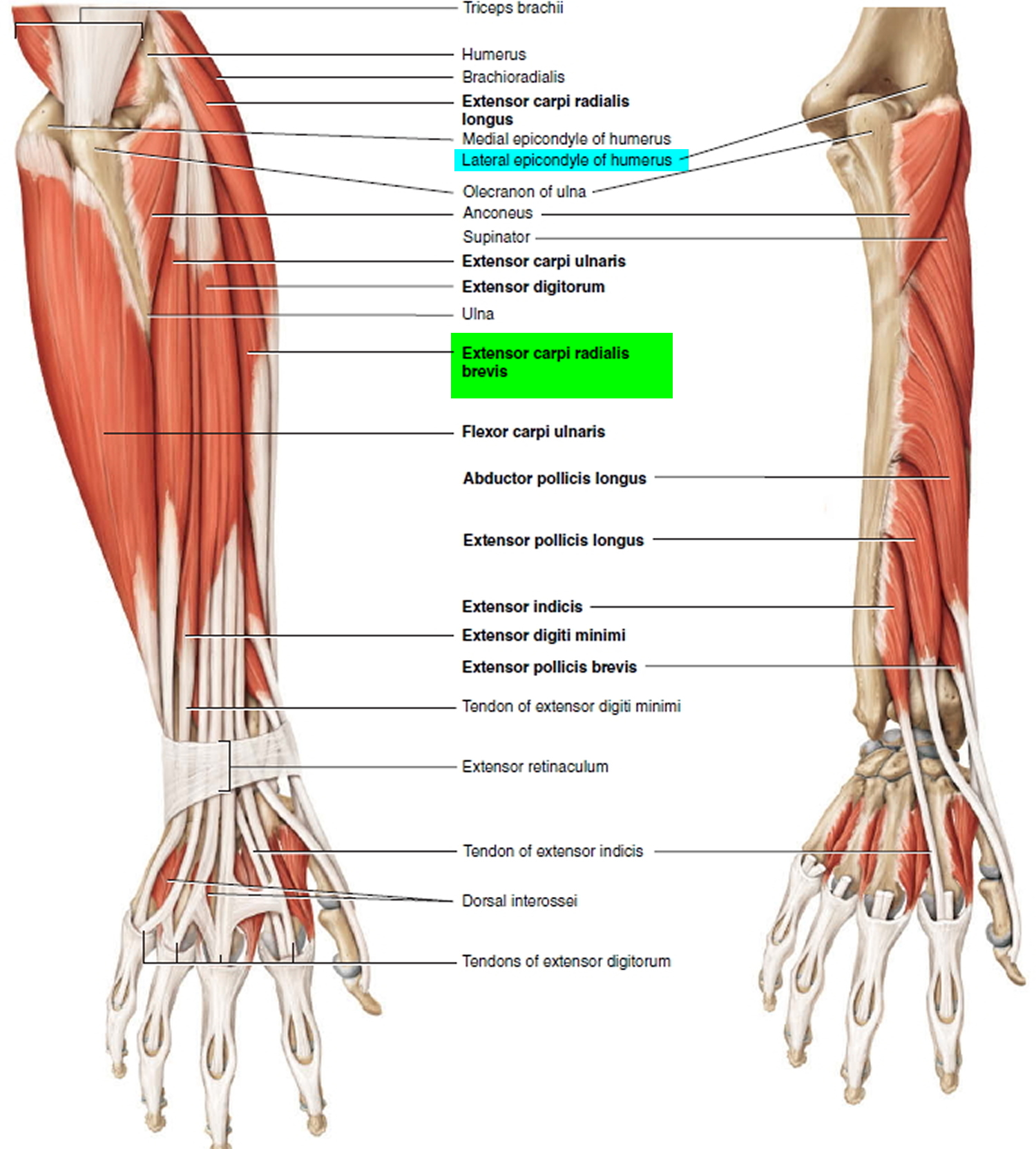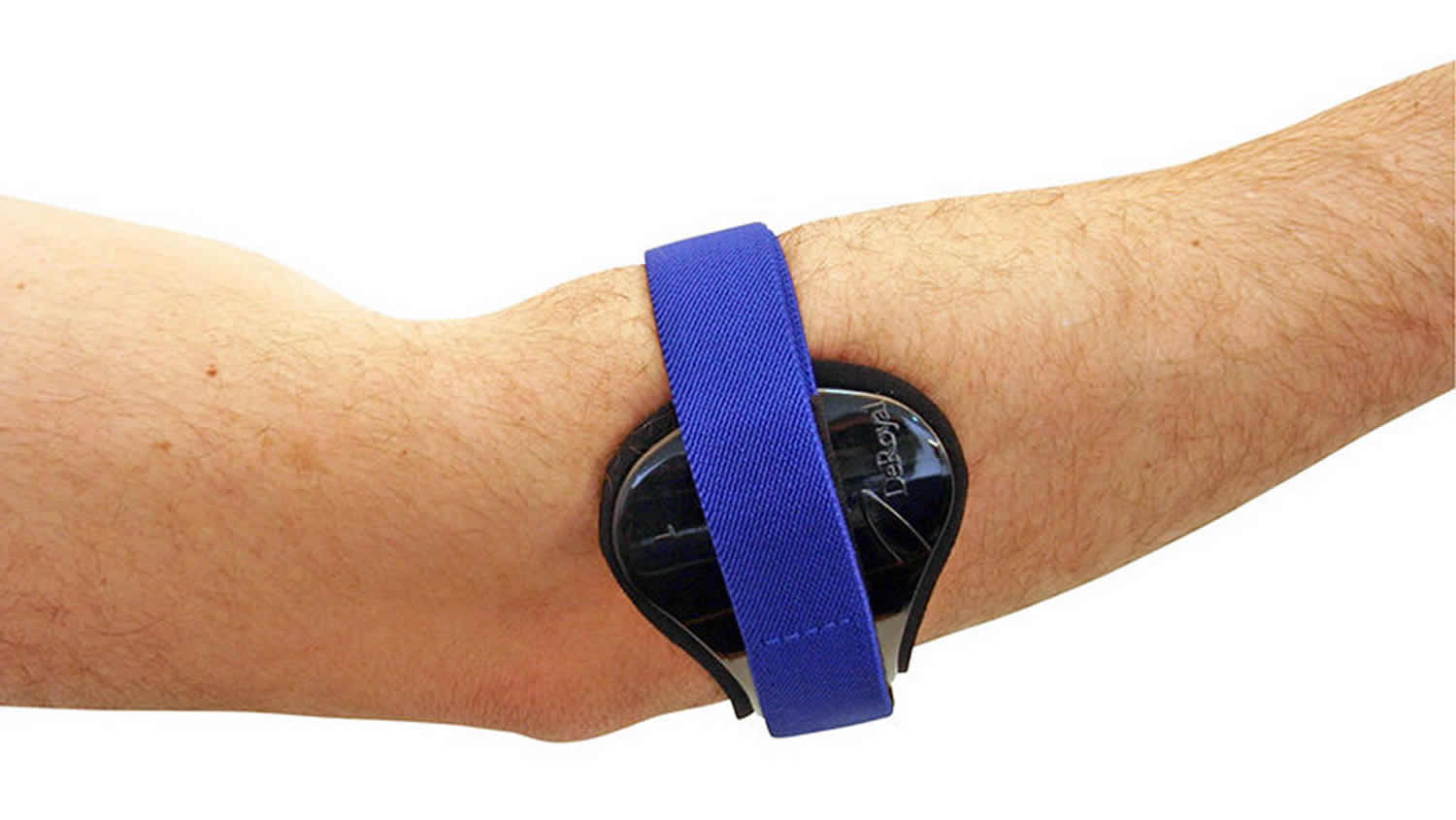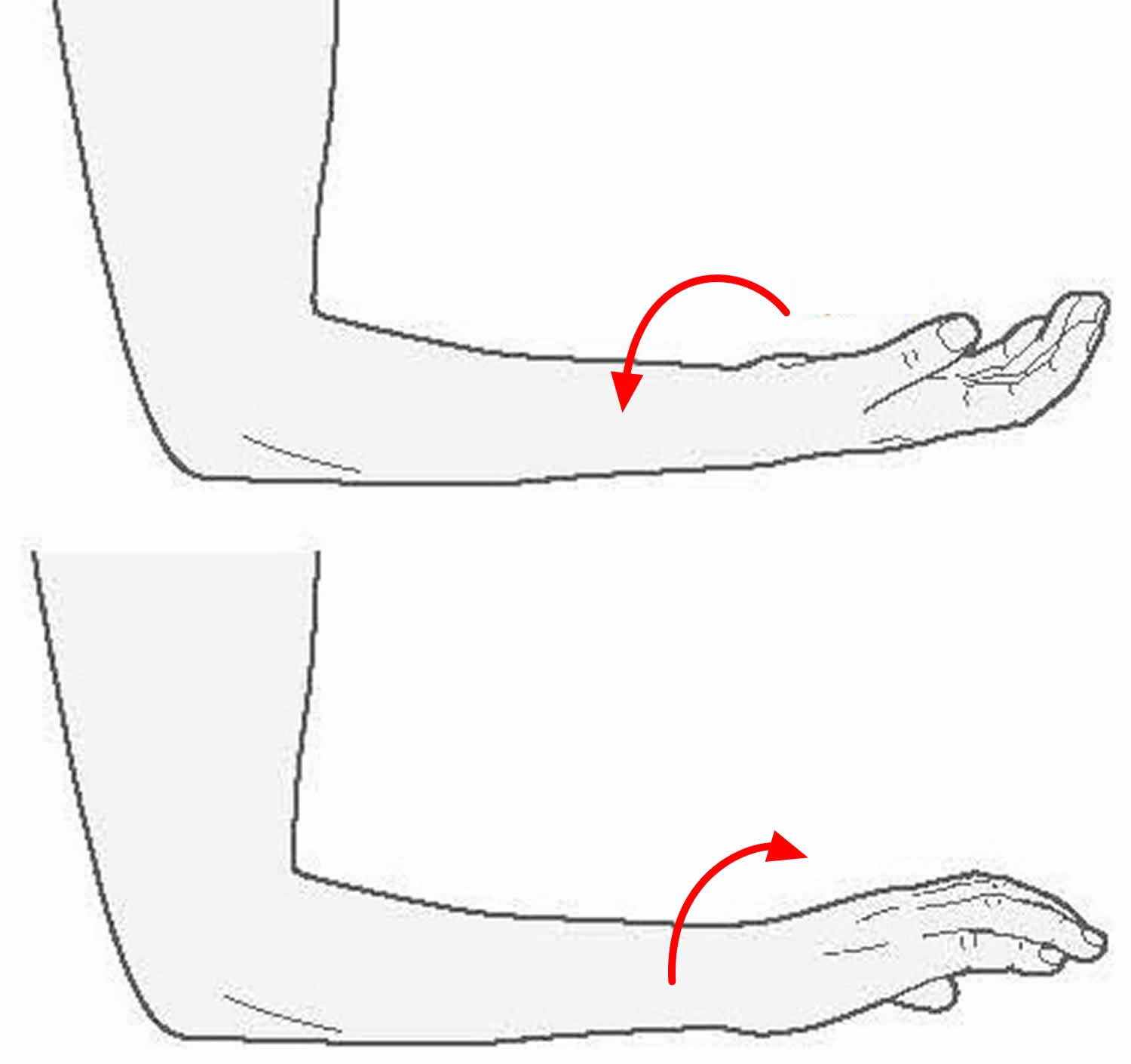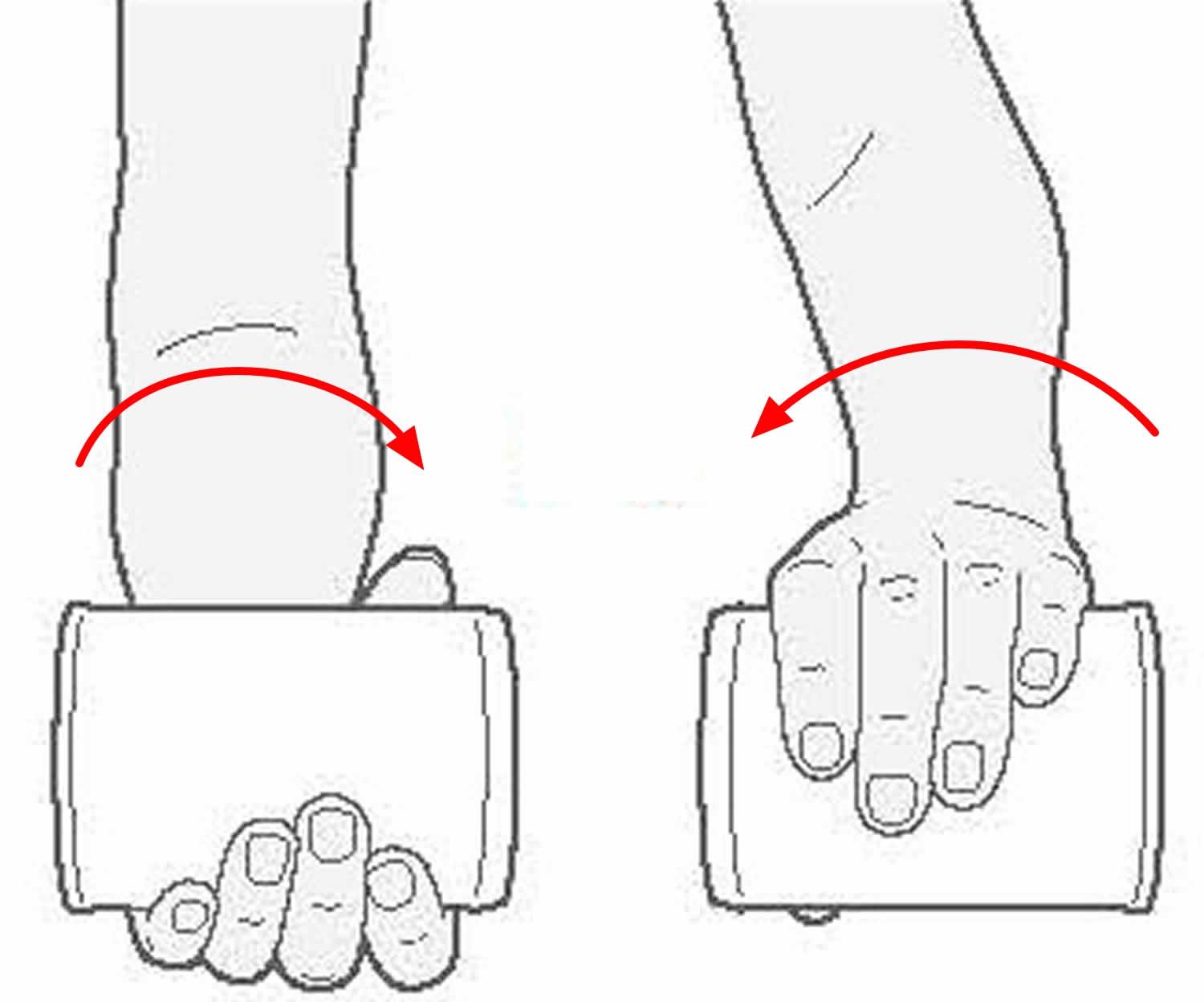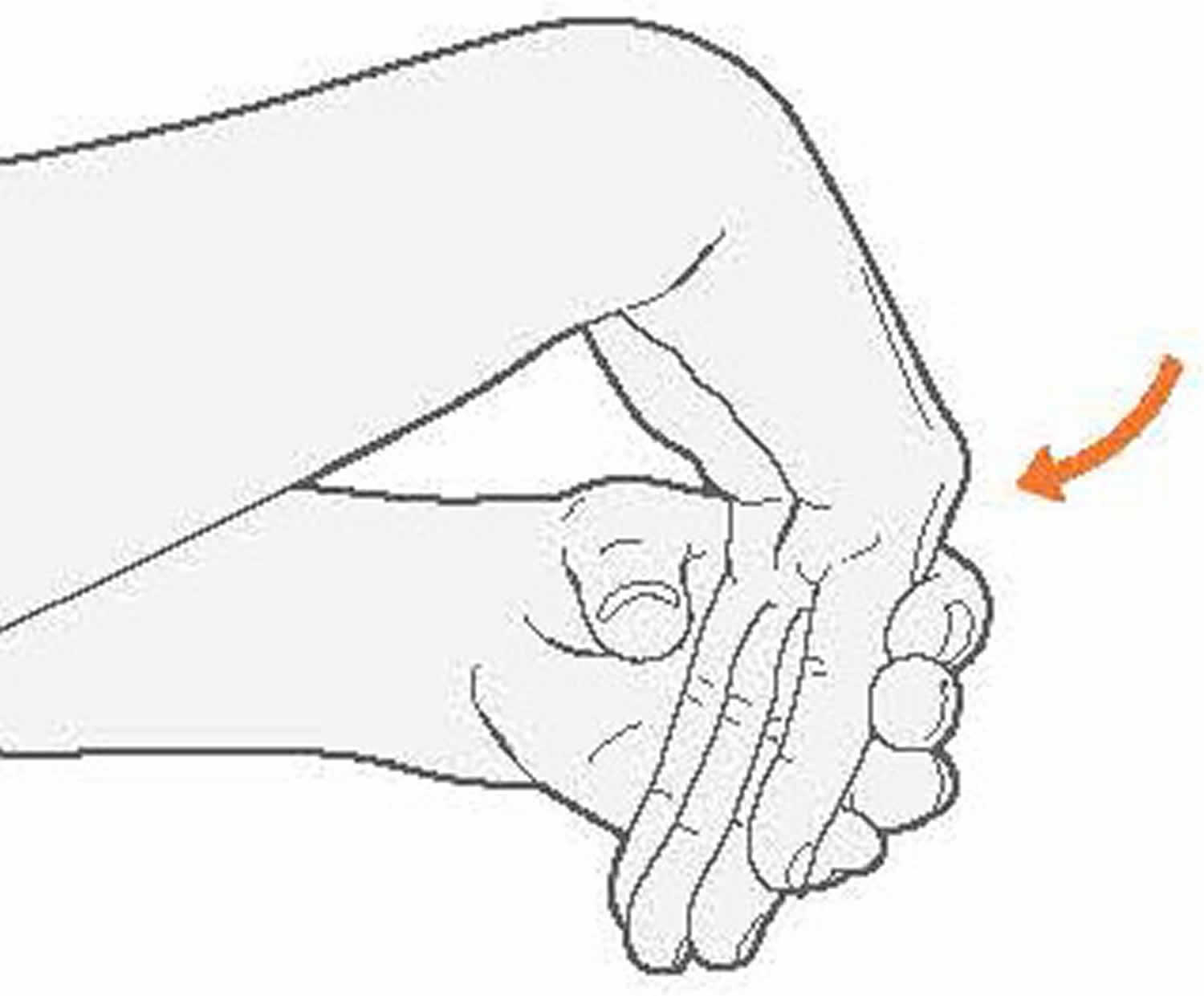Contents
What is tennis elbow
Tennis elbow or lateral epicondylitis, is a painful condition of the elbow caused by overuse 1. Not surprisingly, playing tennis or other racquet sports can cause this condition. However, several other sports and activities can also put you at risk.
Tennis elbow is an inflammation of the tendons (usually the origin of the extensor carpi radialis brevis muscle) that join the forearm muscles on the outside of the elbow (see Figure 1). The tendon usually involved in tennis elbow is called the Extensor Carpi Radialis Brevis. The extensor carpi radialis brevis muscle originates on the lateral epicondyle (thus the name lateral epicondylitis) of the humerus and inserts into metacarpal number 3. The extensor carpi radialis brevis muscle function is to extend and abduct the hand at the wrist joint. The forearm muscles and tendons become damaged from overuse — repeating the same motions again and again. This leads to pain and tenderness on the outside of the elbow.
The basic anatomical cause is sudden and often repeated use of the forearm extensor muscles (extensor carpi radialis brevis muscle), which previously had not been much used 2. Anatomically the extensor carpi radialis brevis arises from the lateral epicondyle of the humerus, passing distally with its neighbor extensor carpi radialis longus. The longus inserts into the base of the second metacarpal, while the brevis largely inserts into the base of the third or central metacarpal of the hand. It is thus the powerful midline extensor of the hand. The occupations, sports, and domestic activities that demand extension of the wrist are myriad. Some examples are plumbing; playing a musical instrument; painting; weaving; raking; using screwdrivers, pliers, and hammers; cutting meat; turning doorknobs; fishing; engaging in arm wrestling, racket sports, and other twisting movements; and lifting objects with an extended wrist. In the days before homes had washers and driers, many young mothers wringing out diapers had symptoms, which perforce rapidly became chronic.
Symptoms vary – tennis elbow usually presents as a small area of chronic pain on the lateral aspect of the elbow (outside of your elbow joint). You may have mild discomfort when you move your arm, or the pain may be bad enough to disturb your sleep. The outside of your elbow will feel tender to the touch and there may be swelling. You may also have pain further down your forearm. Repetitive movements of the wrist will make the pain worse, especially if combined with a weight, for example if you’re lifting boxes. Other characteristic symptoms are pain on wrist extension, pain when shaking hands, and frequently a weakened grip. Even lifting a cup of coffee can precipitate pain. Often there is not one specific incident that produces the symptoms; repeated use of the hand will maintain and often increase the discomfort. An abrupt onset of symptoms is uncommon. In a first occurrence, the pain usually gets worse for several weeks and even months; it may even radiate down the forearm. Work or recreation may commence the condition. Although it can occur at any age, tennis elbow is said to be more common between 30 and 50 years of age.
There are many treatment options for tennis elbow. In most cases, treatment involves a team approach. Primary doctors, physical therapists, and, in some cases, surgeons work together to provide the most effective care.
Initially, simple self-help treatments are probably all you’ll need to clear up your tennis elbow. Most cases will ease within about 2 weeks and you probably won’t need to see a doctor. The first thing you can do to help is to adapt any movements that may be causing your symptoms. For example, lift objects with your palms facing upwards and elbows bent.
Painkillers such as paracetamol (acetaminophen) and ibuprofen may help and you should use them if you need to. It’s important that you take them regularly and at the recommended dose to help you control the pain and allow you to continue exercising. Don’t wait until your pain is severe before taking painkillers. You can also rub anti-inflammatory cream directly onto the painful area.
You shouldn’t take ibuprofen or aspirin if you’re pregnant or have asthma, indigestion or an ulcer until you’ve spoken to your doctor or pharmacist. Medication can have side-effects so you should read the label carefully and check with your pharmacist if you have any queries.
If the pain hasn’t eased over 2–4 weeks you should see your doctor or specialist physiotherapist. They may suggest a steroid injection into the tender area. One injection is probably all you’ll need, though you may still need to rest your elbow for 2–3 weeks afterwards. There’s a slight possibility that the pain will become worse for a few hours after the injection, occasionally lasting for up to 48 hours.
If your elbow pain is affecting your activity and is persisting, ask your doctor about referral to a physiotherapist (physical therapist).
Physiotherapy can help you to manage pain and improve your strength and flexibility. A physiotherapist can provide a variety of treatments, help you understand your problem and get you back to your normal activities.
They may recommend an epicondylitis clasp (tennis elbow brace), which can help reduce the strain on your elbow if you need to make repetitive hand and elbow movements, for example while you’re working.
Figure 1. Elbow joint
Tennis elbow causes
Tennis elbow is an overuse and muscle strain injury. The cause is repeated contraction of the forearm muscles that you use to straighten and raise your hand and wrist. The repeated motions and stress to the tissue may result in a series of tiny tears in the tendons that attach the forearm muscles to the bony prominence at the outside of your elbow.
As the name suggests, playing tennis — especially repeated use of the backhand stroke with poor technique — is one possible cause of tennis elbow. However, many other common arm motions can cause tennis elbow, including:
- Using plumbing tools
- Painting
- Driving screws
- Cutting up cooking ingredients, particularly meat
- Repetitive computer mouse use
Overuse
Recent studies show that tennis elbow is often due to damage to a specific forearm muscle. The extensor carpi radialis brevis muscle helps stabilize the wrist when the elbow is straight. This occurs during a tennis groundstroke, for example. When the extensor carpi radialis brevis muscle is weakened from overuse, microscopic tears form in the tendon where it attaches to the lateral epicondyle. This leads to inflammation and pain.
The extensor carpi radialis brevis muscle may also be at increased risk for damage because of its position. As the elbow bends and straightens, the muscle rubs against bony bumps. This can cause gradual wear and tear of the muscle over time.
Activities
Athletes are not the only people who get tennis elbow. Many people with tennis elbow participate in work or recreational activities that require repetitive and vigorous use of the forearm muscle.
Painters, plumbers, and carpenters are particularly prone to developing tennis elbow. Studies have shown that auto workers, cooks, and even butchers get tennis elbow more often than the rest of the population. It is thought that the repetition and weight lifting required in these occupations leads to injury.
Age
Most people who get tennis elbow are between the ages of 30 and 50, although anyone can get tennis elbow if they have the risk factors. In racquet sports like tennis, improper stroke technique and improper equipment may be risk factors.
Unknown
Lateral epicondylitis can occur without any recognized repetitive injury. This occurence is called “insidious” or of an unknown cause.
Risk factors for developing tennis elbow
Factors that may increase your risk of tennis elbow include:
- Age. While tennis elbow affects people of all ages, it’s most common in adults between the ages of 30 and 50.
- Occupation. People who have jobs that involve repetitive motions of the wrist and arm are more likely to develop tennis elbow. Examples include plumbers, painters, carpenters, butchers and cooks.
- Certain sports. Participating in racket sports increases your risk of tennis elbow, especially if you employ poor stroke technique.
Tennis elbow symptoms
The symptoms of tennis elbow develop gradually. In most cases, the pain begins as mild and slowly worsens over weeks and months. There is usually no specific injury associated with the start of symptoms.
Common signs and symptoms of tennis elbow include:
- Pain or burning on the outer part of your elbow
- Elbow pain that gets worse over time
- Pain that radiates from the outside of the elbow to the forearm and back of the hand when grasping or twisting
- Weak grip strength
Pain and weakness may make it difficult to:
- Shake hands or grip an object
- Turn a doorknob
- Hold a coffee cup
The symptoms are often worsened with forearm activity, such as holding a racquet, turning a wrench, or shaking hands. Your dominant arm is most often affected; however both arms can be affected.
Tennis elbow diagnosis
Your doctor will consider many factors in making a diagnosis. These include how your symptoms developed, any occupational risk factors, and recreational sports participation.
Your doctor will talk to you about what activities cause symptoms and where on your arm the symptoms occur. Be sure to tell your doctor if you have ever injured
your elbow. If you have a history of rheumatoid arthritis or nerve disease, tell your doctor.
During the examination, your doctor will use a variety of tests to pinpoint the diagnosis. For example, your doctor may ask you to try to straighten your wrist and fingers against resistance with your arm fully straight to see if this causes pain. If the tests are positive, it tells your doctor that those muscles may not be healthy.
Tests:
- X-rays. These tests provide clear images of dense structures like bone. They may be taken to rule out arthritis of the elbow.
- Magnetic resonance imaging (MRI) scan. If your doctor thinks your symptoms are related to a neck problem, an MRI scan may be ordered. MRIs scans show details of soft tissues, and will help your doctor see if you have a possible herniated disk or arthritis in your neck. Both of these conditions often produce arm pain.
- Electromyography (EMG). Your doctor may order an EMG to rule out nerve compression. Many nerves travel around the elbow, and the symptoms of nerve compression are similar to those of tennis elbow.
Tennis elbow treatment
Tennis elbow often gets better on its own. But if over-the-counter pain medications and other self-care measures aren’t helping, your doctor may suggest physical therapy. Severe cases of tennis elbow may require surgery. Most people respond well to treatment. You might have some pain during work or sports for up to 6 to 12 weeks. Some people will need formal rehabilitation with a physical therapist.
How to treat tennis elbow at home
Approximately 80% to 95% of patients have success with nonsurgical treatment. Simple self-help treatments are probably all you’ll need to clear up your tennis elbow. Most cases will ease within about 2 weeks and you probably won’t need to see a doctor. The first thing you can do to help is to adapt any movements that may be causing your symptoms. For example, lift objects with your palms facing upwards and elbows bent.
Rest. The first step toward recovery is to give your arm proper rest. This means that you will have to stop participation in sports or heavy work activities for several weeks.
Non-steroidal anti-inflammatory (NSAIDs) medicines. Drugs like aspirin, naproxen or ibuprofen reduce pain and swelling. It’s important that you take them regularly and at the recommended dose to help you control the pain and allow you to continue exercising. Don’t wait until your pain is severe before taking painkillers. You can also rub anti-inflammatory cream directly onto the painful area.
You shouldn’t take ibuprofen or aspirin if you’re pregnant or have asthma, indigestion or an ulcer until you’ve spoken to your doctor or pharmacist. Medication can have side-effects so you should read the label carefully and check with your pharmacist if you have any queries.
Equipment check. If you participate in a racquet sport, your doctor may encourage you to have your equipment checked for proper fit. Stiffer racquets and looser-strung racquets often can reduce the stress on the forearm, which means that the forearm muscles do not have to work as hard. If you use an oversized racquet, changing to a smaller head may help prevent symptoms from recurring.
Tennis elbow brace
Using a brace centered over the back of your forearm may also help relieve symptoms of tennis elbow. This can reduce symptoms by resting the muscles and tendons.
Figure 2. Tennis elbow brace (epicondylitis clasp)
Tennis elbow physical therapy
Specific exercises are helpful for strengthening the muscles of the forearm. Your physical therapist may also perform ultrasound, ice massage, or muscle-stimulating techniques to improve muscle healing.
Your pain should ease within 2 weeks and you should recover over approximately a 4–6 week period.
You should carry on with the exercises for at least 6–8 weeks after the pain disappears to help prevent symptoms returning.
Tennis elbow exercises
Wrist turn
Bend your elbow at a right angle and hold out your hand, palm up.
Turn your wrist slowly so that your palm is now facing down.
Hold for 5 seconds, and then slowly release.
Do 3 sets of 10 repetitions.
Figure 3. Wrist turn
Wrist turn with weight
Repeat the exercise while holding a light weight (e.g. a tin of beans).
Figure 4. Wrist turn with weight
Wrist lift (palm up)
Bend your elbow at a right angle.
Hold a light weight (e.g. a tin of beans), palm up.
Bend your wrist slowly towards you.
Hold for 5 seconds, and then slowly release.
Do 3 sets of 10 repetitions.
Figure 5. Wrist lift (palm up)
Elbow bend
Stand up straight and lower your arm to one side.
Bend your arm slowly upwards so your hand is touching your shoulder.
Hold for 15–30 seconds.
Repeat 10 times.
Figure 6. Elbow bend
Wrist flex
Keeping your arm straight in front with your palm facing down, gently bend your wrist down.
Use the opposite hand to press the stretching hand back towards your body and hold for 15–30 seconds.
Straighten your wrist.
Gently bend the stretching hand backwards and use the opposite hand to pull the fingers back.
Hold for 15–30 seconds. Do 3 sets with each wrist.
Figure 7. Wrist flex
Steroid injections
Steroids, such as cortisone, are very effective anti-inflammatory medicines. Your doctor may decide to inject your damaged muscle with a steroid to relieve your symptoms.
One injection is probably all you’ll need, though you may still need to rest your elbow for 2–3 weeks afterwards. There’s a slight possibility that the pain will become worse for a few hours after the injection, occasionally lasting for up to 48 hours.
Extracorporeal shock wave therapy
Shock wave therapy sends sound waves to the elbow. These sound waves create “microtrauma” that promote the body’s natural healing processes. Shock wave therapy is considered experimental by many doctors, but some sources show it can be effective.
Platelet-rich plasma
Platelet-rich plasma is currently being investigated for its effectiveness in speeding the healing of a variety of tendon injuries. Platelet-rich plasma is a preparation developed from a patient’s own blood. It contains a high concentration of proteins called growth factors that are very important in the healing of injuries. Current research on platelet-rich plasma and lateral epicondylitis is very promising. A few treatment centers across the country are incorporating platelet-rich plasma injections into the nonsurgical treatment regimen for lateral epicondylitis. However, this method is still under investigation and more research is necessary to fully prove platelet-rich plasma’s effectiveness.
Tennis elbow surgery
If your symptoms do not respond after 6 to 12 months of nonsurgical treatments, your doctor may recommend surgery.
Most surgical procedures for tennis elbow involve removing diseased muscle and reattaching healthy muscle back to bone.
The right surgical approach for you will depend on a range of factors. These include the scope of your injury, your general health, and your personal needs. Talk with your doctor about the options. Discuss the results your doctor has had, and any risks associated with each procedure.
Open surgery
The most common approach to tennis elbow repair is open surgery. This involves making an incision over the elbow.
Open surgery is usually performed as an outpatient surgery. It rarely requires an overnight stay at the hospital.
Arthroscopic surgery
Tennis elbow can also be repaired using miniature instruments and small incisions. Like open surgery, this is a same-day or outpatient procedure.
Surgical risks
As with any surgery, there are risks with tennis elbow surgery. The most common things to consider include:
- Infection
- Nerve and blood vessel damage
- Possible prolonged rehabilitation
- Loss of strength
- Loss of flexibility
- The need for further surgery
Rehabilitation
Following surgery, your arm may be immobilized temporarily with a splint. About 1 week later, the sutures and splint are removed.
After the splint is removed, exercises are started to stretch the elbow and restore flexibility. Light, gradual strengthening exercises are started about 2 months after surgery.
Your doctor will tell you when you can return to athletic activity. This is usually 4 to 6 months after surgery. Tennis elbow surgery is considered successful in 80% to 90% of patients. However, it is not uncommon to see a loss of strength.

